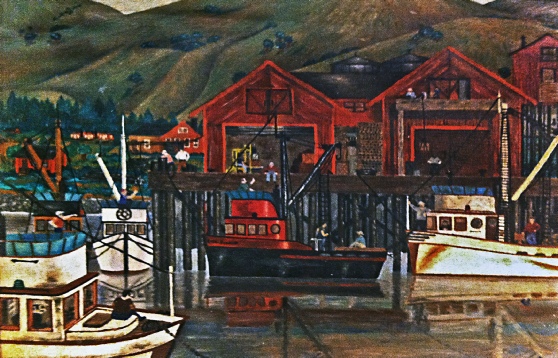Evangel Island Journey 3 – The Evangel Visits Kaguyak and Shearwater
By Timothy Smith (restored and expanded 2020)
Author’s note: Kaguyak village and Shearwater Cannery (Kadiak Fisheries) were both completely destroyed in the Tidal Wave of March 27, 1964. There was much loss of life when the villagers of Kaguyak had no way to get to high ground, and the waves rolled into the bay with deadly force. This article celebrates a happier time, when both places were favorite stops on the Evangel journeys. The few photos Dad took are now precious and historic.
Beautiful Little Kaguyak

The village of Kaguyak from the side, circa 1953
Our next stop in our southbound journey is the village of Kaguyak. It has a much smaller population than most of the island villages, and even fewer amenities, but it is a friendly and inviting place. The village is laid out following the pattern of many of the ancient archaeological digs: a sheltered harbor, low, flat land for dwellings, and a fresh water supply. With its face toward a shallow bay and its back to a beautiful freshwater lake, Kaguyak had probably existed for hundreds of years before the Russian traders came. I have nothing but pleasant memories of my visits there, and this visit is no exception.
The wide beach and shallow bay at Kaguyak, 1953. Kids hanging out around a wooden skiff, Blazo box ready to be used to haul supplies – it is an evocative scene of a rural Alaskan fishing village. (my brother Noel Smith is on the far right)

As we pull into the shallow bay and head toward shore in the skiff, there is already
a small group of kids waiting for us on the wide beach. We get provided with dinner
shortly after we arrive, in the form of a nice, plump, newly-
The fishing boats around Kaguyak in the mid-

There aren’t many people in Kaguyak, and many of the residents are off fishing or
working in canneries, but there's quite a handful of children and young people. Later
that evening, a small flotilla of skiffs brings most of the residents of town out
to the Evangel for some filmstrips and fellowship. Dad starts the little generator,
Mom has the pump organ unpacked, and we hold a little service, including the popular
animated filmstrips based on Bible stories. Somehow, Mom has produced Kool-
It is a festive time, but eventually everyone has to go ashore. I ride along as Dad
ferries some of the kids back to the beach. The brightly-

This 1960 publicity (staged) photo from a Baptist publication shows Norman and Joyce Smith in the cabin of the Evangel. The kids were most likely volunteers from the Kodiak Baptist Mission. Too bad this is a newsprint photo, since no better interior ones exist.
The Evangel was used in this way at many canneries and smaller villages like Kaguyak. The famous “Christ Our Pilot” painting and the folding pump organ are visible behind Joyce. My sister Robin, with young brother Kelly on her lap, is at the far end of the bench. My head might be barely visible in the front row, far right. The people in the center of the cabin are sitting on folding stools that stored away when not needed. The engine room door is behind Norman.
The village of Kaguyak from the lake behind the village, in this historic shot taken in 1957. The photo shows the wide, shallow bay beyond the village, opening to the north, the very direction that the waves came from in the 1964 Tidal Wave disaster. And high ground is nowhere near the village.

Epitaph for Kaguyak
Kaguyak's beautiful and ideal location became its undoing. When the 9.2 Great Alaskan Earthquake generated a series of tsunamis on March 27, 1964, Kaguyak was destroyed. With its shallow bay too close to the open ocean, Kaguyak was inundated by high, cresting waves when the tsunami came roaring in. Many lives were also lost. After the Tidal Wave, the surviving residents relocated to Old Harbor and Akhiok.


In the interest of history, here are two more photos from Kaguyak, blurry 16mm movie frames taken seconds apart, and processed differently. The photos in this article are among the very few color photos of Kaguyak available anywhere. At least we have these!
Shearwater Cannery (Kadiak Fisheries)
The Evangel leaves Shearwater cannery in a light rain, in the summer of 1956.

Epitaph for Shearwater
We frequently visited Shearwater on our south-
Because this website has been online since the late 1990’s, I have occasionally received bits and pieces of information that would add to these articles. A man sent me an email about fifteen years ago, and attached was an informal photo of a painting on the wall of his parents’ home. The painter has taken a few liberties, but it is obviously Shearwater, at the height of its life as a cannery. I used this painting as a backdrop logo for my supplemental essay on old local canneries, a new addition to my “Cannery Work in Kodiak” article.
The next article is “The Evangel Visits Akhiok and Alitak.” To go back to the Evangel Index, please click on the logo below:



To Find Out More About Tanignak.com, Click HERE
To Visit My “About Me” Page, Click HERE

To Get Back “Home”
Please Click on the Site Logo Below:

Information from this site can be used for non-